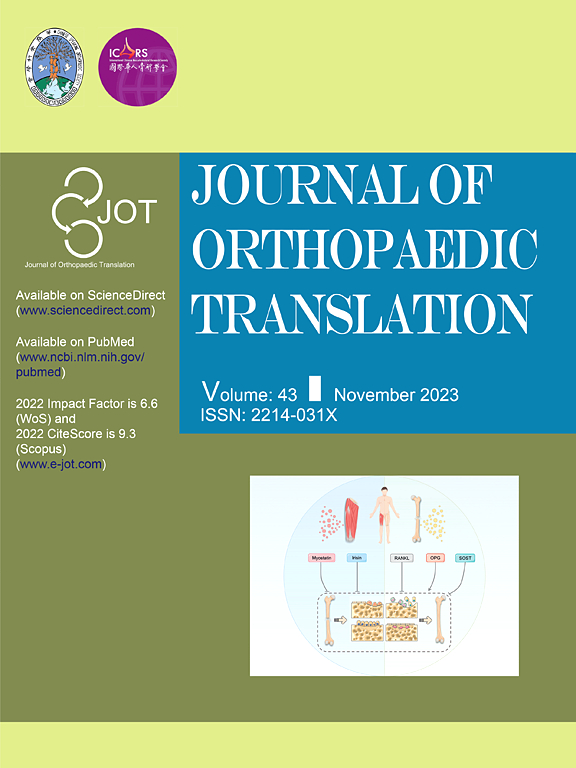1990-2021年亚洲骨折的流行病学和疾病负担:对2021年全球疾病负担研究的分析
IF 5.9
1区 医学
Q1 ORTHOPEDICS
引用次数: 0
摘要
骨折是一个重要的全球公共卫生问题,造成了巨大的经济负担,特别是在老年人中。然而,关于亚洲骨折负担的研究仍然有限,这突出表明需要进行全面和最新的研究,以支持整个地区医疗保健资源的有效规划和分配。方法使用全球疾病负担(GBD) 2021数据库,我们分析了亚洲地区与骨折负担相关的年龄标准化发生率(ASIR)、患病率(ASPR)和残疾生存年限(YLDs) (ASYR)。我们的研究探讨了随着时间的推移,年龄、性别和国家的变化趋势,并检查了骨折负担与社会人口指数(SDI)之间的相关性。结果2021年,亚洲地区骨折发生率为9130万例(95%不确定区间,83.65 ~ 99.47),患病率为23271万例(95%不确定区间,215.57 ~ 250.39),YLDs为1297万例(95%不确定区间,8.89 ~ 17.82),发病率(ASIR)为1968.49例(95%不确定区间,1799.15 ~ 2147.14),患病率(ASPR)为4683.96例(95%不确定区间,4347.58 ~ 5036.61),每10万人YLDs (ASYR)为261.72例(95%不确定区间,179.43 ~ 358.94)。尽管绝对负担较高,但亚洲的年龄标准化骨折率略低于全球平均水平。对于ASYR,最严重的骨折是髌骨、胫骨/腓骨/踝关节、髋关节和骨盆。1990年至2021年间,亚洲的骨折发生率、流行病例和YLDs显著增加。观察到年龄和性别差异,老年人的骨折负担最重,尤其是女性髋部骨折。男性总体骨折负担较高,而女性在老年人群中面临更大的骨折疾病负担。从地理上看,高收入的亚太地区和中亚地区的年龄标准化YLD率最高,而南亚和东亚地区的骨折和YLD数量最多。结论sour研究对亚洲地区的骨折负荷进行了深入的分析。从1990年到2021年,亚洲地区总体年龄标准化骨折负担逐渐下降,但髋部骨折负担持续增加。亚洲是全球裂缝负担绝对数量最高的地区,东亚和南亚是造成这一负担的主要地区。在亚洲,骨折负担随着年龄的增长而增加,在老年群体中,女性的骨折负担高于男性。加强监测和有针对性的预防对于减少未来的骨折负担至关重要。骨折是亚洲地区发病率高、疾病负担重的健康问题。尽管1990年至2021年亚洲骨折的总体疾病负担有所下降,但从发病率和流行率来看,1990年至2021年亚洲髋部骨折疾病负担持续上升。在亚洲,男性的骨折负担高于女性,但在2021年,女性在老年人群中有更高的骨折疾病负担。本文章由计算机程序翻译,如有差异,请以英文原文为准。

Epidemiology and disease burden of fractures in Asia, 1990–2021: An analysis for the Global Burden of Disease Study 2021
Background
Fractures are a significant global public health concern, imposing a substantial economic burden, particularly among the elderly. However, research on the fracture burden in Asia remains limited, highlighting the need for comprehensive and up-to-date studies to support the effective planning and allocation of healthcare resources across the region.
Methods
Using the Global Burden of Disease (GBD) 2021 database, we analyzed the age-standardized rates (ASRs) of incidence (ASIR), prevalence (ASPR), and years lived with disability (YLDs) (ASYR) associated with fracture burden across Asia. Our study explored trends over time, variations by age, sex, and country, and examined the correlation between fracture burden and the sociodemographic index (SDI).
Results
In 2021, fractures in Asia caused 91.3 million (95 % uncertainty interval, 83.65–99.47) incident cases, 232.71 million (95 % UI, (215.57–250.39) prevalent cases, and 12.97 million (95 % UI, 8.89–17.82) YLDs, with age-standardized rates of 1968.49 (95 % UI, 1799.15–2147.14) for incidence (ASIR), 4683.96 (95 % UI, 4347.58–5036.61) for prevalence (ASPR), and 261.72 (95 % UI, 179.43–358.94) for YLDs (ASYR) per 100,000 population. Despite a higher absolute burden, Asian age-standardized rates of fracture were slightly lower than the global average. For ASYR, the most burdensome fractures were those of the patella, tibia/fibula/ankle, hip, and pelvis. Between 1990 and 2021, fracture incident cases, prevalent cases, and YLDs in Asia increased markedly. Age and sex differences were observed, with the elderly experiencing the highest fracture burden, particularly for hip fractures in women. While men had a higher overall fracture burden, women faced a greater fracture disease burden in the elderly population. Geographically, High-income Asia Pacific and Central Asia exhibited the highest age-standardized YLD rates, while South and East Asia had the largest number of fractures and YLDs.
Conclusions
Our study provides an in-depth analysis of the fracture burden in Asia. From 1990 to 2021, the overall age-standardized fracture burden in Asia showed a gradual decline, yet the burden of hip fractures continued to increase. Asia holds the highest absolute number of fracture burden globally, with East Asia and South Asia being the primary regions contributing to this burden. The fracture burden increases with age in Asia, and women experience a higher fracture burden than men in older age groups. Strengthening surveillance and targeted prevention is essential to reduce the future fracture burden.
The translational potential of this article
Fracture is a kind of health problem with high incidence and serious disease burden in Asia. Although overall burden of disease for fractures in Asia from 1990 to 2021 was decreasing, the burden of hip fracture disease in Asia has continued to rise from 1990 to 2021 in terms of incidence and prevalence. Males had a higher fracture burden than females in Asia, yet females had a higher fracture disease burden in the elderly population in 2021.
求助全文
通过发布文献求助,成功后即可免费获取论文全文。
去求助
来源期刊

Journal of Orthopaedic Translation
Medicine-Orthopedics and Sports Medicine
CiteScore
11.80
自引率
13.60%
发文量
91
审稿时长
29 days
期刊介绍:
The Journal of Orthopaedic Translation (JOT) is the official peer-reviewed, open access journal of the Chinese Speaking Orthopaedic Society (CSOS) and the International Chinese Musculoskeletal Research Society (ICMRS). It is published quarterly, in January, April, July and October, by Elsevier.
 求助内容:
求助内容: 应助结果提醒方式:
应助结果提醒方式:


